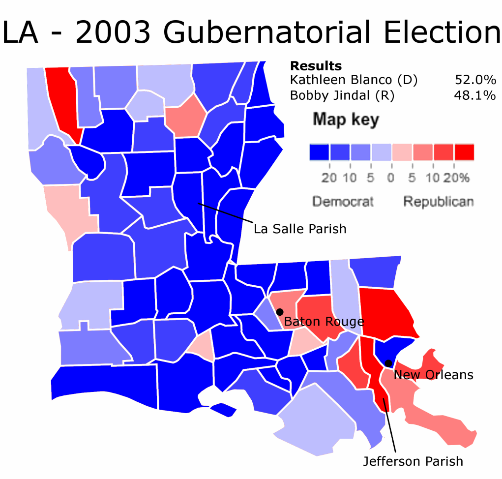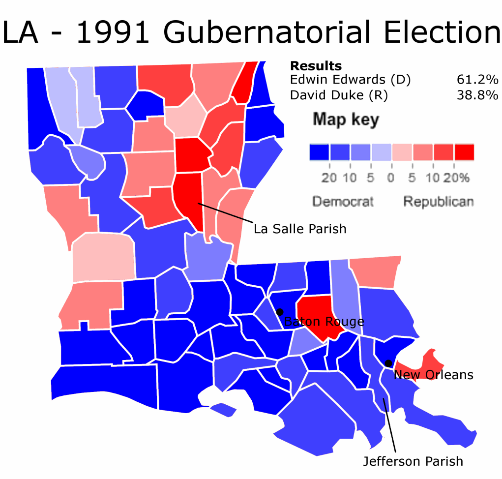This is the second part of two posts analyzing Louisiana’s 2003 gubernatorial election, in which Republican candidate Bobby Jindal narrowly lost to lieutenant governor Kathleen Blanco. It will focus on racial dynamics in the 2003 election. The previous part can be found here.
Race and Bobby Jindal’s 2003 Run
In my previous post, I began analyzing the electoral coalition that voted for Mr. Jindal. As a map of the election below indicates, he drew support heavily from the New Orleans suburbs, while doing extremely poorly in the rural north:
More below.
Discomfort with Mr. Jindal’s race probably accounted for most his underperformance in the rural north. Take La Salle Parish, for instance. Located in the northern stretches of Louisiana, the parish constitutes a typical example of the rural conservatism that backs much of the Republican Party. The district is very thinly populated; in 2003 less than 5,000 people voted in total. It is also quite poor; 2000 census figures indicate that per capita income was only two-thirds of the American average. And it is 86% white.
Like many of its rural peers, La Salle Parish usually votes Republican. It gave Senator John McCain 85.5% of the vote – which probably means that every single white person voted for Mr. McCain, and that every single black person voted for Mr. Obama. Mr. Jindal, however, received less than 40% of the vote in this staunch Republican district.
Interestingly enough, Mr. Jindal also did unremarkably with black voters. Exit polls indicated that he drew about 9% of the black vote in 2003. This was better than most Louisiana Republicans, but not exactly an impressive performance (reaching more than 20%, or even 15%, of black support is considered an extremely strong performance for a Republican politician – especially in the Deep South). African-Americans, it appeared, did not seem to view Mr. Jindal much differently from a typical white Republican in Louisiana.
White voters in rural Louisiana apparently did. A look at white supremacist David Duke’s 1991 run for governor provides a revealing context:
Of the 19 deeply conservative, mostly rural parishes that voted for Mr. Duke, only four could bring themselves to vote for a deeply conservative but non-white Republican. Mr. Duke won two-thirds of the vote in La Salle Parish.
On the other hand, Mr. Duke lost almost all of Louisiana’s conservative southeast; he only managed to win one of the suburban New Orleans parishes Mr. Jindal dominated. These parishes vote equally Republican, if not more so, as places like La Salle Parish.
The disparate supporters of Mr. Jindal and Mr. Duke point to an interesting division in the Republican coalition of Louisiana. Usually this division is not noticed, since Republicans generally hold it together well; only rarely does one leg of the coalition bolt altogether, as in the gubernatorial elections of 1991 and 2003.
Nevertheless, there are indeed two parts of Louisiana’s Republican base. One part, represented by northern Louisiana, is largely rural and poor; in bygone days it formed the core of both Huey Long’s support and the Solid South. The other, located largely in the suburbs surrounding New Orleans, is mostly suburban and relatively wealthy; it will vote for a Bobby Jindal but not a David Duke.
Indeed, these two strands of Republicanism are present not just in Louisiana but throughout the nation. Which strand the Republican Party decides to model itself after in the future will play a great deal in shaping the future of the party, as well as that of the nation.
Post-mortem: Following his 2003 defeat, Mr. Jindal campaigned heavily in the rural regions that had voted against him. In 2007, the Republican was elected governor with 54.3% of the vote; his next closest opponent won 17.6%. Mr. Jindal won almost every parish in the state, including many of the rural, conservative parishes that had voted against him in 2003 – proving that racism is not an impossible obstacle to surmount.
–Inoljt, http://mypolitikal.com/


affect this?
but I have to say, this is very interesting analysis.
He may have won a number of parishes with pluralities with the Dem vote exceeding 50%.